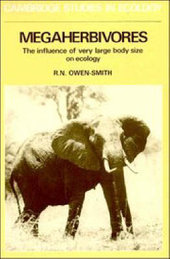
|
Megaherbivores: The Influence of Very Large Body Size on Ecology
Paperback / softback
Main Details
| Title |
Megaherbivores: The Influence of Very Large Body Size on Ecology
|
| Authors and Contributors |
By (author) R. Norman Owen-Smith
|
| Series | Cambridge Studies in Ecology |
|---|
| Physical Properties |
| Format:Paperback / softback | | Pages:388 | | Dimensions(mm): Height 228,Width 151 |
|
| Category/Genre | Ecological science
Mammals |
|---|
| ISBN/Barcode |
9780521426374
|
| Classifications | Dewey:599.7 |
|---|
| Audience | | Professional & Vocational | |
|---|
| Illustrations |
40 Tables, unspecified; 47 Halftones, unspecified; 40 Line drawings, unspecified
|
|
Publishing Details |
| Publisher |
Cambridge University Press
|
| Imprint |
Cambridge University Press
|
| Publication Date |
5 March 1992 |
| Publication Country |
United Kingdom
|
Description
The largest land mammals are constrained in their activities by their large body size, a theme that is emphasized in this account of their general ecology. The book begins by raising the question as to why these once abundant and widely distributed 'megaherbivores' - elephants, rhinos, hippos and giraffes - have all but gone extinct, and ends by considering the implications of the answer for the conservation of the remaining populations. Existing megaherbivores are placed in the context of the more numerous species which occurred worldwide until the end of the last Ice Age, and knowledge of the ecology of surviving species is used to analyse the cause of the extinctions. The information and ideas contained in this book are of crucial importance to all concerned with halting the rapidly worsening conservation status of remaining elephant and rhinoceros species, and carries a wider message for those concerned with the ramifying effects of man on ecosystem processes. Graduate students and research scientists in ecology, conservation biology and wildlife management will find this book of value.
Reviews."..a model example of this ecological-role based comparative approach, as well as being a highly informative review of what is known about the extant megaherbivore species." John Damuth, Ecology "This book deserves to be bought and widely read by all ecologists, paleobiologists, and wildlife managers with an interest in large animals." Journal of Animal Ecology "This book shows well how various elements of their biology are interrelated, transcending phylogenetic boundaries, a tribute to convergent evolution." Quarterly Review of Biology
|